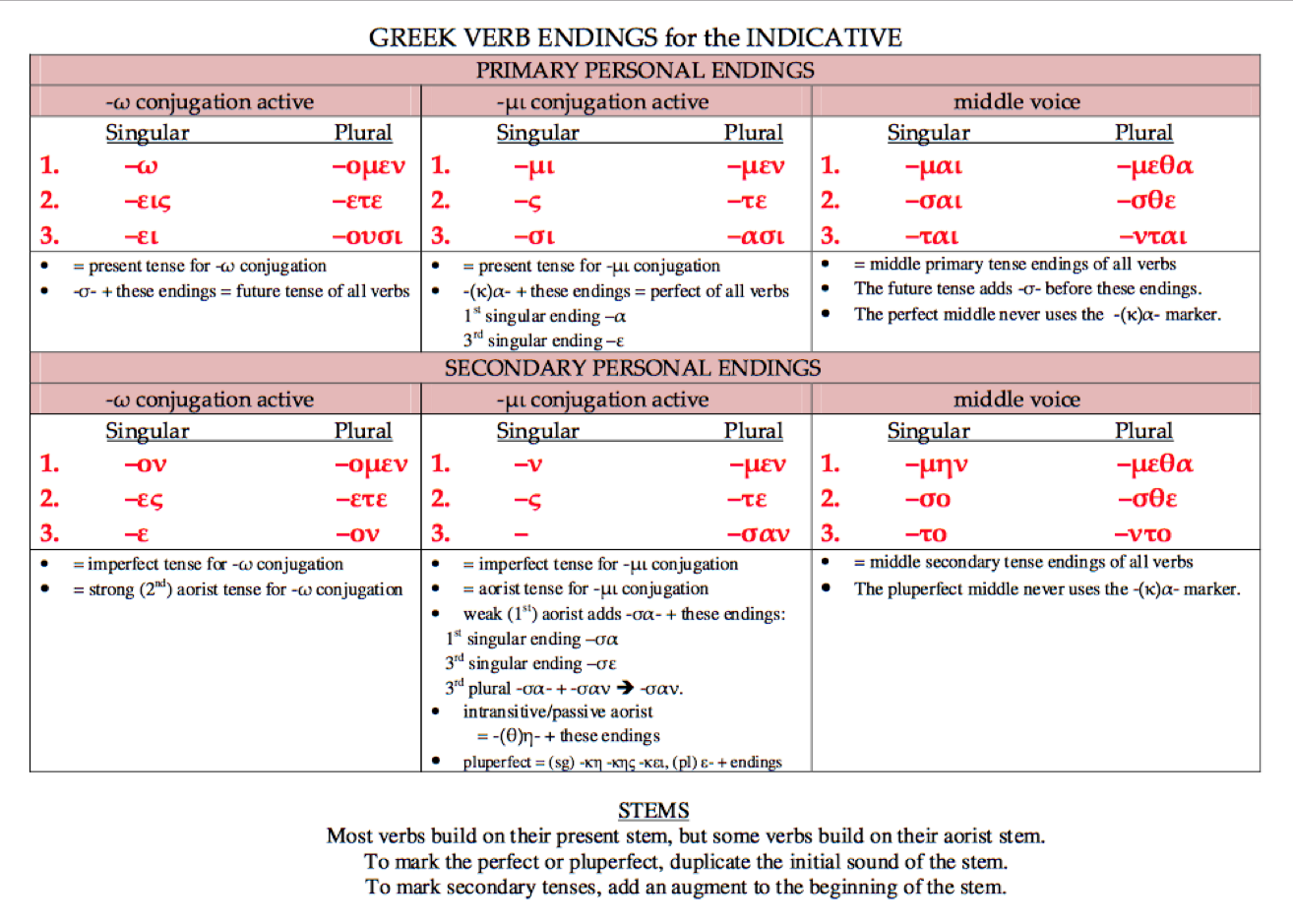34

The Middle Voice
Recall that PRIMARY and SECONDARY tenses use distinct personal endings. Let us review again the following chart, which shows the overall scheme of verb endings (pdf version here: Greek Verbs: Master List of Endings).
Here we can see that we have learned the three sets of PRIMARY ENDINGS (-μι, –ω or –μαι). Note the differences and similarities between the PRIMARY MIDDLE and the SECONDARY MIDDLE endings.
The MIDDLE VOICE uses the SAME PERSONAL ENDINGS to designate person and number for all SECONDARY TENSES. Athematic –μι verbs will add these endings directly to the stem.
Remember, though, that –ω verbs have a thematic vowel (-ο/-ε) that is added before these endings. Note that the second person singular regularly appears in a contracted form that results from the loss of the INTERVOCALIC SIGMA (S 628).
|
–ομην = I (1st person singular) |
–ομεθα = we (1st person plural) |
|
(-εσο →) –oυ = you (2nd person singular) |
–εσθε = y’all (2nd person plural) |
|
–ετο = (s)he, it (3rd person sg) |
–οντο = they (3rd person pl) |
–εσθαι signals that a verb is in the infinitive.
The Middle Voice: Imperfect Tense
Recall that verbs in the imperfect tense have the same stem as the present tense. Two additional markers combine to indicate the imperfect tense:
- An augment (ἐ-) precedes the present tense stem.
- Secondary tenses of Greek verbs use secondary endings.
Putting it all together, the imperfect tense stem looks like this:
- ἐδεικνυ show (in the imperfect)
- ἐλυ loosen (in the imperfect)
- ἐλαμβαν take (in the imperfect)
To form the MIDDLE VOICE of the IMPERFECT, simply add the SECONDARY MIDDLE endings.
The Imperfect, Indicative, Middle of δείκνυμι (athematic) (S 418; GPH p. 157)
|
ἐδεικνύμην |
ἐδεικνύμεθα |
|
ἐδείκνυσο |
ἐδείκνυσθε |
|
ἐδείκνυτο |
ἐδείκνυντο |
The Imperfect, Indicative, Middle of λύω (thematic) (S 383; GPH p. 70)
|
ἐλυόμην |
ἐλυόμεθα |
|
(ἐλύεσο →) ἐλύου |
ἐλύεσθε |
|
ἐλύετο |
ἐλύοντο |
The Imperfect, Indicative, Middle of λαμβάνω (thematic)
|
ἐλαμβανόμην |
ἐλαμβανόμεθα |
|
(ἐλαμβάνεσο →) ἐλαμβάνου |
ἐλαμβάνεσθε |
|
ἐλαμβάνετο |
ἐλαμβάνοντο |
The Middle Voice: –μι Verbs in the Imperfect Tense
The following –μι verbs all form the IMPERFECT MIDDLE regularly, according to the following rules:
- Short stem vowels are used for all stems
- The intervocalic σ in the 2nd person singular does NOT drop out (S 744). This same phenomenon happens with the Present Middle of these –μι verbs (i.e., δίδοσαι, τίθεσαι, ἵστασαι, and ἵεσαι)
The Imperfect, Indicative, Middle of δίδωμι (S 416; GPH p. 124)
|
ἐδιδόμην |
ἐδιδόμεθα |
|
ἐδίδοσο |
ἐδίδοσθε |
|
ἐδίδοτο |
ἐδίδοντο |
The Imperfect, Indicative, Middle of τίθημι (S 416; GPH p. 146)
|
ἐτιθέμην |
ἐτιθέμεθα |
|
ἐτίθεσο |
ἐτίθεσθε |
|
ἐτίθετο |
ἐτίθεντο |
The Imperfect, Indicative, Middle of ἵστημι (S 416; GPH p. 135)
|
ἱστάμην |
ἱστάμεθα |
|
ἵστασο |
ἵστασθε |
|
ἵστατο |
ἵσταντο |
Note: This verb has a long vowel augment, but it does not affect the way the vowel is written, since long and short ι are written the same.
The Imperfect, Indicative, Active of ἵημι (S 777)
|
ἱέμην |
ἱέμεθα |
|
ἵεσο |
ἵεσθε |
|
ἵετο |
ἵεντο |
Note: This verb has a long vowel augment, but it does not affect the way the vowel is written (since long and short ι are written the same).
The Middle Voice: Contract Verbs in the Imperfect Tense
The rules of vowel contraction operate in verbs when the stem ends in one of the vowels α, ε or ο. In these cases, this final vowel of the stem contracts with the thematic vowel of –ω verbs.
The Imperfect, Indicative, Middle of αἱρέω
|
(ἐ–αἱρεόμην →) ᾑρούμην |
(ἐ–αἱρεόμεθα →) ᾑρούμεθα |
|
(ἐ–αἱρέεσο →) ᾑροῦ |
(ἐ–αἱρέεσθε →) ᾑρεῖσθε |
|
(ἐ–αἱρέετο →) ᾑρεῖτο |
(ἐ–αἱρέοντο →) ᾑροῦντο |
The Imperfect, Indicative, Middle of ἐρωτάω
|
(ἐ–ερωταόμην →) ἠρωτώμην |
(ἐ–ερωταόμεθα →) ἠρωτώμεθα |
|
(ἐ–ερωτάεσο →) ἠρωτῶ |
(ἐ–ερωτάεσθε →) ἠρωτᾶσθε |
|
(ἐ–ερωτάετο →) ἠρωτᾶτο |
(ἐ–ερωτάοντο →) ἠρωτῶντο |
The Imperfect, Indicative, Middle of δηλόω (GPH p. 119)
|
(ἐδηλοόμην →) ἐδηλούμην |
(ἐδηλοόμεθα →) ἐδηλούμεθα |
|
(ἐδηλόεσο →) ἐδηλοῦ |
(ἐδηλόεσθε →) ἐδηλοῦσθε |
|
(ἐδηλόετο →) ἐδηλοῦτο |
(ἐδηλόοντο →) ἐδηλοῦντο |
– τὸ τέλος –
Paradigms, Key Terms and Concepts
- Chapter Paradigms
- ATHEMATIC MIDDLE VOICE SECONDARY ENDINGS
- THEMATIC MIDDLE VOICE SECONDARY ENDINGS
Exercises
Ι. Conjugate in full the following verbs in the imperfect middle. Remember that there is no infinitive.
- ἐθέλω
- ποιέω
- δίδωμι
- τίθημι
- ἵστημι
- ἵημι
ΙΙ. Review the Greek Verbs: Master List of Endings chart. Download a blank version of the chart here: Master List of Verb Endings Blank. Practice filling out the chart from memory.

